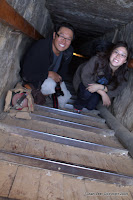One of the Views into the Men's (left) & Women's (right) Exterior Courtyard at the Western Wall
The Western Wall aka Wailing Wall or the Kotel is an important Jewish religious site located in the Old City of Jerusalem. The reason why its called the Western Wall is because its the Western most wall of the Temple Mount. An interesting thing to note about the Temple Mount is that -- what you see today is actually the SECOND Temple that was reconstructed by Herod the Great around 19 BCE and additional layers were added in the 7th century onwards by other ruling empires. The First Temple, built by King Solomon, was destroyed in 586 BCE when the Jewish nation was exiled to Babylon. What you see today is only part of the Second Temple as parts of the Western Wall are located below street level (which, I'm sure you didn't know; and is too much to write about here, but if you want to read more, click here for more info on Second Temple).
Some interesting notes about the wall:
- Though the Western Wall is commonly referred to as the "Wailing Wall", Jewish people never refer to this holy place as the Wailing Wall - only as the Western Wall. The name gained popularity from 19th century literature where people used to call it the "Place of Weeping"... A description that stemmed from a Jewish practice where Jewish people came to "speak" to the wall -- often "mourning" or giving prayer requests... and mourning the destruction of their temple. (A third temple has been rumored to be built, but nothing has occurred).
- There is so much history here that it is even difficult for me to grasp and remember, but for this blog posting, suffice to say -- that after the Roman Empire and the Spanish, Turkish Ottoman, British, Jordanian ruling and now the Israeli ruling, this area of the Western Wall has been designated as a holy place for Jewish people to to devote their prayers (part of the 1930 International Commission) without interruption or interference.
- The exposed Western Wall, or the one you mostly see, refers to an 187 ft stretch of the wall, but actually it stretches 1,600 ft. Where is the other part you may ask? Its "hidden" behind residential structures built along its length.The height of the wall is 105 ft, with the exposed section approx. 62 ft. There are 45 stone courses, of which 28 of them are below ground level. Each stone weights anywhere from two to eight tons, with the largest weighing approx. 570 tons (found on the Northern side). Its amazing how this structure was even created! The area is thought to have been a limestone quarry centuries ago (hence the very large limestone blocks), so that may have helped place the stone into place
- You can visit, with a fee of course, the lower parts of the wall. Its actually an interesting tour and I highly recommend it. The guide books say you need a reservation, but my brother and I were able to get a ticket without one (but you may need a reservation if you go in peak season).
- The Western Wall is supposed to the sole remnant of the Holy Temple and is the "CLOSEST" spot to the holiest spot in Judaism -- the Foundation Stone -- which is expected to be housed inside the Dome of the Rock (others say it is situated opposite of the exposed section of the Western Wall), which is located inside the Temple Mount in the Muslim Quarter. Interestingly enough, Jews are forbidden from setting foot upon the Temple Mount and is considered a sin punishable by Kareth. WHAT?!?! So, one of holiest places located in the Muslim quarters ... can not be accessed by Jews and is considered a sin!
- Every year, more than a million notes, or prayer requests, are placed in the wall crevices. The notes are collected twice a year and buried on the Mount of Olives. If you can not be there to place it, you can even fax in your request to have it placed there. The likes of Pope John Paul II, Barack Obama and Pope Benedict XVI have placed messages in the wall
- The wall is segregated by gender, which I found surprising (and I will have to ask my Jewish friends why). Are women a substandard class or is this my American ignorance and prejudice towards American society (even though, we all know not everyone is created equal)? I started to think this when I compared my experience with that of my brother's.... here are some of the stark differences. Male's side: Exterior area was nearly double the size of the female side; there was a library and discussion room, not to mention a separate prayer room where rabbis would be present (um, did we mention that only males are allowed to be rabbi's); meanwhile, the female side had a small prayer room, and when I say small, I am not exaggerating -- it would be the size equivalent of two or maybe three restaurant sized bathrooms! you will have to see the photos.
Inside a small study room is a private sanctuary to pray (left). Within the Western Wall's crevices are small notes, or prayer requests left behind by visitors.







































